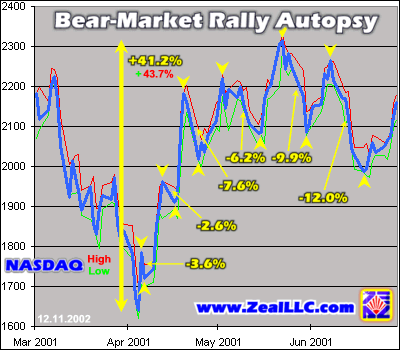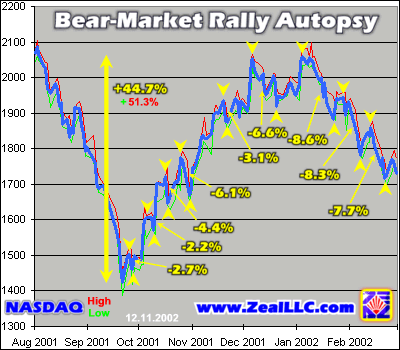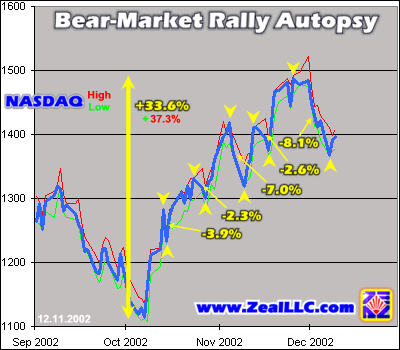|
|
|||||||
|
|
|
|
|
|
|
|
|
|
Bear-Market Rally Autopsy Adam Hamilton December 13, 2002 2935 Words
Before it gasped its final breath in May 2002, the only television series I really enjoyed was Chris Carter’s outstanding “The X-Files”.
The excellent series chronicled the strange journeys into the unexplained by a pair of FBI agents who were called in when crimes and crime scenes defied all attempts at conventional explanations. Each week agents Fox Mulder and Dana Scully explored some new surreal and bizarre crime scene or delved deeper into a fantastically complex web of government conspiracies and paranoia.
Agent Scully was the rational scientific type of the excellent chemistry-filled pairing. As both an FBI special agent and a medical doctor her extensive training led her to always seek rational logical answers as a counterbalance to her partner agent Mulder’s quick embrace of the paranormal or forces unknown to explain a crime.
When Mulder and Scully began investigating a new mystery each week, one of the staple X-Files scenes involved Dr. Scully performing an autopsy on the victim. These autopsies were always a special treat for viewers because without fail something really weird and totally unexplainable would turn up which would advance the plotline of that particular episode and sometimes the entire series.
The X-Files autopsies were masterfully used to create suspense, advance the storyline, and to let the viewer in on some special knowledge which would prove critical. Much was learned in these signature autopsy scenes that proved very beneficial later on in the hour.
This week as my partners and I were discussing the recent powerful bear-market rally in US equities, I found myself pondering the X-Files autopsies. Like most other investors and speculators, we seek insight and wisdom into future market movements by throwing the naked past up onto a cold, stainless-steel autopsy table and dispassionately dissecting it.
Sometimes a post-mortem autopsy of the market past yields excellent insights and sometimes it unfortunately merely leaves a bloody mess on the autopsy table. Yet this very Great Bear against which we are all valiantly battling these days has allowed three massive bear-market rallies in the past two years, so perhaps its modus operandi in the past can provide clues on what to expect in the future.
Is our current bear-market rally in US equities finally giving up its ghost? Or does it still have farther to run?
As I mentioned last week, some outstanding technical indicators like the Put/Call Ratio indicate this bear-market rally is probably already over and others like the venerable VIX suggest it may yet still have some life left in it. With these two powerful indicators not singing in perfect harmony on the near-future market direction as traders prefer to see, perhaps an autopsy of the three massive bear-market rallies since early 2001 can yield some more clues.
While thankfully we have already been blessed with some excellent early unrealized profits in our latest stock-index speculations outlined in the new December issue of Zeal Intelligence, much uncertainty remains over the immediate fate of our current bear-market rally. As always the more uncertainty that investors and speculators can dispel, the better the information will be on which they base their decisions. The better the information, the higher the probability of achieving wildly profitable trades!
So, in the spirit of Dr. Dana Scully’s fearless X-Files’ autopsies we are shifting gears a bit this week and dissecting the carcasses of the last three massive NASDAQ bear-market rallies themselves. Rather than relying solely on the exogenous technical indicators like the VIX and PCR 21dma that we usually pay homage to, perhaps valuable clues lie within the steaming entrails of the deceased bear rallies themselves.
The three massive bear rallies we dragged up onto the stainless-steel autopsy table were born on April 4th, 2001, September 21st, 2001, and October 9th, 2002. While we did have to zoom in and execute these dissections under a tactical magnifying glass as the graphs below show, these major bear rallies are also quite evident from a strategic perspective.
Each of the three enormous bear-market rallies dissected below sticks out like an elephant trying to hide under your living-room rug even when viewed from altitude far above the muddy market battlefields.
The methodology for our bear-market rally autopsies this week is simple. We wanted to see if there are any signature price patterns or decay that is common among all three episodes that could potentially mark the end of the bear-market rally in which we currently sojourn. In order to compare the rallies, we measured each major pullback in each rally within its entire lifecycle. Perhaps a common thread would emerge that grants us some valuable clues on the Great Bear’s modus operandi.
You probably remember the first of our specimens, a super-impressive monster of a bear rally that erupted in early April 2001. Shortly after, Alan Greenspan launched a frantic surprise inter-meeting 50bp rate cut and Wall Street perma-bulls zealously declared that the bear market was finally over.
Then, ensuring that I wouldn’t get invited to any Wall Street Christmas parties in 2001, I wrote a controversial essay published May 11th, 2001 called “Equity Bulls in Denial” with the audacity to brazenly claim that “the bear market in the US is just beginning, NOT ending as most bulls and bullish-bears assert today. This current NASDAQ, DJIA, and S&P action looks and smells like a bear market rally, as there is no fundamental foundation for the spectacular gains since early April.”
As far as bear-market rallies go, this was certainly an impressive specimen. It rocketed up slightly over 41% in only 33 trading days on a closing basis. Using intraday numbers, the daily highs and lows that are marked above with the red and green lines, the rally soared almost 44% trough to peak. It was no doubt an exciting few months of market action!
The distinctively spiny shape carved in the graph above just begs to be dissected and analyzed. In this autopsy, we are focusing on the pullbacks, normal ultra-short-term bearish episodes punctuating the bear-market rally itself. Next to each pullback, bound by the yellow arrowheads, the actual percentage of the pullback on a closing basis is marked. The evolution of the magnitude of these pullbacks is quite interesting.
Early on in a bear rally, folks are just relieved that the bottom didn’t fall out on the preceding bounce and they buy with reckless abandon. With popular greed rampant, temporary sell-offs tend to be quite small and they are soon offset with heavy buying which once again propels the bear-market rally on to dazzling new heights. Note above how the first pullback approached only 4% and the second not even 3%, quite modest for the hyper-volatile NASDAQ casino.
Yet, later in a bear rally, after the markets have run up 20%, 30%, even 40% in a matter of weeks, investors and speculators begin to grow nervous. They start expecting a major pullback and begin to fear that the end of the bear-market rally draws nigh. This fearful psychology leads to more selling with each pullback as speculators want to ensure that they have harvested at least some of their profits before the bear rally fails.
At this late stage in the evolution of a normal bear-market rally, the pullbacks grow much larger. Note above how the early small pullbacks gave way to a pullback approaching 8% and then another slightly over 6%. The pullbacks, initially small in the bear rally, generally begin to grow as the rally matures and popular greed fades.
Then, seemingly out of the blue the bear-market rally suddenly reaches its interim top almost as mystically and without fanfare as when it had earlier emerged out of the mists of popular despair when it was born. Following the top, each pullback seems to grow in magnitude, becoming more powerful and difficult to overcome for the remaining bulls. As the rally above topped, the next two pullbacks weighed in at about 10% and 12%, four times as large as the early-stage pullbacks!
Like a car fishtailing on ice, the bear-rally pullbacks began as small oscillations when the bulls were in full control early on, but as they lost more and more control the pullbacks grew larger and larger. When a rear-wheel-drive car starts fishtailing on an icy winter road, its initial lateral movements are small, but the driver overcorrects, and each subsequent fishtailing slide is larger and larger until control is totally lost and the car crashes, or the bear rally collapses.
In this first bear rally autopsied above, it is provocative that these bear-rally pullbacks start small initially, soon grow larger, and finally get huge as the bear rally inevitably fails. Is this distinct signature also seen in the other two massive NASDAQ bear-market rallies we have witnessed in recent years?
Let’s roll this first bear-rally carcass and its guts off our stainless-steel autopsy table and make room for our second dearly-departed bear-market rally. It surged to life following the infamous events of September 2001. While the bear rally was due anyway before the Towers fell, the attacks had the psychological effect of forcing the markets even lower before they bounced and the misplaced financial-market patriotism pushed the following bear rally even higher than it would have probably normally run.
As the bear rally was born popular greed soared and Wall Street once again emphatically declared that the bear was finally dead and a glorious new bull market in equities had been miraculously reborn from the ashes of 9/11 like a phoenix.
Ever the belligerent contrarian, once again I did my best to call a spade a spade and warn people that this too was merely a bear-market rally that would soon collapse. In “Bear Market Rallies” published on November 23rd, 2001 I said, infuriating the perma-bulls yet again, “the odds are vastly in favor of the bearish thesis that the current US equity rallies are little more than seductive bear market rallies that will ultimately collapse to new lows.” Sheesh, you can’t take me anywhere!
This bear-market rally augmented by the horribly shameful and morally degenerate Wall Street repackaging of national patriotism and sorrow with the buying of overvalued US equities was simply enormous. Its trophy-grade carcass barely fits on our dissection table for autopsy with a whopping trough-to-peak gain of almost 45% on a closing basis. From its intraday trough to its intraday peak, this magnificent bear rally rocketed up by an unfathomable 51%+! Bear rallies in major equity indices don’t get much bigger than this fellow.
Since this specimen ran so high and lasted so long compared to a typical bear-market rally, there are more major pullbacks for us to examine. The dissection of these pullbacks is also quite interesting, especially in light of our post-mortem observations of bear-market rally numero uno discussed above.
As you can see in the graph, the first few pullbacks right after this bear rally’s birth were small, running about 3%, 2%, and 4%, right in line with what we observed above. Extreme greed and relief ruled the roost and early selling was quickly met with massive buy orders from speculators trying to buy the dips just as Wall Street evangelists preach for them to do.
Then, just as in the first specimen, as this bear rally reached middle age and its last legs, its pullbacks generally grew. It witnessed pullbacks of about 6%, 3%, and 7%. The 3% is quite small, but the 6% and 7% bracketing it were notable pullbacks. Deploying the fishtailing car analogy once again, as the bear-market rally aged its mini-bearish internal oscillations grew more and more severe.
Finally, just as above, the terminal pullbacks immediately after the top weighed in at about 9%, 8%, and 8%, big numbers. As soon as the 8%+ pullback level was reached, the bear rally was over as bearish forces had finally overcome the immense bullish inertia that initially fueled the bear-market rally. Early pullbacks of low single-digit percentages gave way to later pullbacks of mid single-digit percentages. Ultimately the bear rally gave up its ghost on high single-digit percentage pullbacks just like its ancestor immediately before it.
On a sidenote, there is one other interesting observation to ponder in the bearish entrails sliced open above. The final bear-rally top on a closing basis, the one right before the 8.6% pullback, occurred a few days before the ultimate intraday top. You can see the final intraday top as a spike in the light red intraday-high line above to 2100. This development may appear trivial, but as any X-Files fan knows sometimes the slightest observations can break a case wide open.
Perhaps the final intraday spike above marked the last gasping breath of the bulls. They launched a valiant assault on new highs to try to keep the bear rally alive but it was repelled by deeply entrenched bearish defenders and the NASDAQ didn’t close anywhere near its high that day. This big negative divergence may be a post-mortem fingerprint of the hard-to-detect psychological turning point when the majority of speculators have finally switched from greed to fear mode.
Well, with two bear-rally autopsies completed we can now focus our attention on today’s impressive bear-rally specimen which burst onto the scene in October 2002. It is not quite as beefy as its ancestors, but it still yielded immense profits for those courageous enough or foolish enough to throw countertrend long for a couple months or so in the midst of a brutal supercycle bear-market bust.
Lest you fear that I am some Johnny-come-lately to this bear-rally party like most of the talking heads on television, please consider my comments in the “Trading Volatility Ratios” essay published on October 4th, 2002, a few days before our current specimen was born. Earning the undying wrath of the perma-bears I dared to utter these blasphemous words, “If the SPX/VIX ratio proves true to its golden historical track-record, we are in for a spectacular bear market rally that will knock the socks off those not expecting it and yield legendary profits for those who are.” Now the bears won’t invite me to their Christmas parties either! Sigh.
Look familiar? We have all just traveled down this intriguing road. This particular massive bear-market rally was up a respectable 34%ish in closing terms or about 37% from its intraday trough to peak. But is it over yet? The PCR 21dma is sure signaling the death knell of this bear rally as discussed last week, but the VIX still steadfastly suggests it can run higher from here. Can our autopsy break this deadlock in the warring elite technical indicators?
Not surprisingly the modus operandi of the Great Bear this time around is the same as during the last two massive bear-market rallies in the NASDAQ.
Early in this bear-market rally we witnessed the requisite small pullbacks, 4% and 2% this time around. Then as this bear rally matured a 7% pullback was registered as the magnitude of the mini-bearish oscillations flying in the face of the short-term bullish tide increased. A subsequent smaller 3%ish pullback then ensued, similar to what we observed as we peeled back the flesh in specimen numero dos discussed above.
Déjà vu eh? The Great Bear is kindly standing aside to let the bulls frolic this time just as it has the last two times before it roared out of the shadows like a juggernaut and slaughtered the terrified bulls with one mighty claw-studded swipe. The comparisons among the three massive bear rallies’ internals are quite provocative and ominous.
The killer X-Files-like suspense really soars when looking at the latest December pullback though. It has shed a little over 8% peak to trough thus far. If you scroll back up and examine the previous two graphs, you will note that none of the previous bear-market rallies has ever recovered from an 8%+ pullback! Under 8% seems manageable for some reason, the bulls can overcome a sub-8% pullback to corral the bear-market rally even higher. But any pullback over 8% has so far proven to be an insurmountable hurdle for the stampeding bulls to overcome.
In addition to the dark tidings of this fresh 8%+ pullback, you will also notice a large intraday NASDAQ spike a couple days after the closing interim top to date marked by the red line above. As you remember from our second specimen’s autopsy, this final last gasp by the charging bulls seemed to mark a subtle turning point in general psychology. From this moment forward last time around the bears once again gained the upper hand over the bulls in short-term-speculation land!
An 8%+ pullback coupled with a delayed failed intraday attempt to extend the life of this particular bear rally offer more evidence that this bear-market rally already has one foot in the grave. While it certainly could still run higher, the PCR sell signal discussed last week coupled with these decidedly bearish technical internals suggest the scales of probability are now drastically tilted towards the short side in the coming months.
Dr. Scully would have been proud of our cursory bear-market rally autopsy!
Speculators may wish to prepare accordingly by deploying potentially immensely profitable short-side-oriented trades as we discussed for our subscribers in Zeal Intelligence this month. Investors may wish to consider moving capital out of the overvalued US equities into cash or gold and silver stocks to ride out the coming brutal general stock-index downleg.
Take cover, as the bears are once again regaining the balance of short-term power.
Adam Hamilton, CPA December 13, 2002 Subscribe |
|||||||
|
|
|
|
|
|
|
|
|
|
|
|
|
|
|
|||



